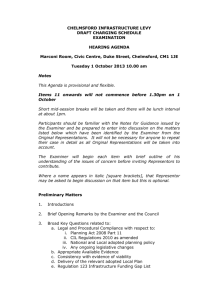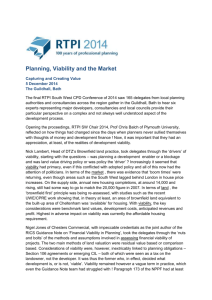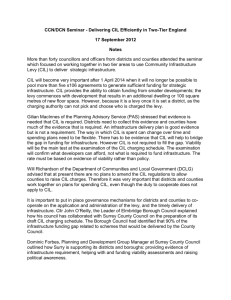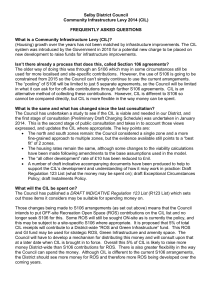Howard Osbourne NT20131209 RS CIL reps
advertisement
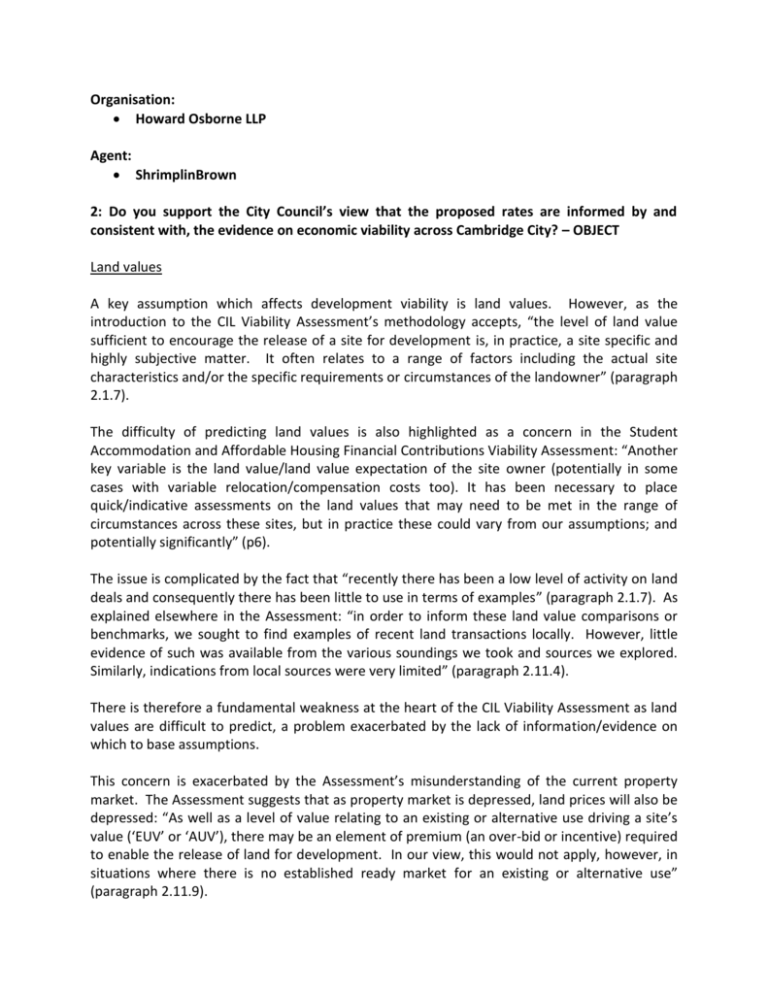
Organisation: Howard Osborne LLP Agent: ShrimplinBrown 2: Do you support the City Council’s view that the proposed rates are informed by and consistent with, the evidence on economic viability across Cambridge City? – OBJECT Land values A key assumption which affects development viability is land values. However, as the introduction to the CIL Viability Assessment’s methodology accepts, “the level of land value sufficient to encourage the release of a site for development is, in practice, a site specific and highly subjective matter. It often relates to a range of factors including the actual site characteristics and/or the specific requirements or circumstances of the landowner” (paragraph 2.1.7). The difficulty of predicting land values is also highlighted as a concern in the Student Accommodation and Affordable Housing Financial Contributions Viability Assessment: “Another key variable is the land value/land value expectation of the site owner (potentially in some cases with variable relocation/compensation costs too). It has been necessary to place quick/indicative assessments on the land values that may need to be met in the range of circumstances across these sites, but in practice these could vary from our assumptions; and potentially significantly” (p6). The issue is complicated by the fact that “recently there has been a low level of activity on land deals and consequently there has been little to use in terms of examples” (paragraph 2.1.7). As explained elsewhere in the Assessment: “in order to inform these land value comparisons or benchmarks, we sought to find examples of recent land transactions locally. However, little evidence of such was available from the various soundings we took and sources we explored. Similarly, indications from local sources were very limited” (paragraph 2.11.4). There is therefore a fundamental weakness at the heart of the CIL Viability Assessment as land values are difficult to predict, a problem exacerbated by the lack of information/evidence on which to base assumptions. This concern is exacerbated by the Assessment’s misunderstanding of the current property market. The Assessment suggests that as property market is depressed, land prices will also be depressed: “As well as a level of value relating to an existing or alternative use driving a site’s value (‘EUV’ or ‘AUV’), there may be an element of premium (an over-bid or incentive) required to enable the release of land for development. In our view, this would not apply, however, in situations where there is no established ready market for an existing or alternative use” (paragraph 2.11.9). However, this fundamentally misunderstands the property market. The difficulty in securing development finance and the lack of development activity focuses attention on those few markets that remain strong. Cambridge is one of these, and the result is much higher, rather than lower, land values. This reinforces the fundamental weakness of the Assessment that it does not properly understand land values. The implications of this misunderstanding are far reaching. As the introduction to the Assessment acknowledges, under the subheading “notes and limitations”; “…small changes in assumptions can have a significant individual or cumulative effect on the residual land value generated and/or the value of the CIL funding potential (the surplus after land value comparisons)” (paragraph 1.2.2). S106 and CIL The CIL Viability Assessment has factored into its calculations an allowance of £1,000/dwelling for s106 contributions necessary to bring forward sites (paragraph 2.10.1). For strategic sites and allowance of £400,000/gross hectare is made (paragraph 2.10.2). However, no such allowance is made for other development types. This anomaly places student accommodation, which has the same proposed CIL level as for residential, at a significant disadvantage. 3: Do you support the City Council’s view that the rates proposed represent an appropriate balance between the desirability of funding infrastructure and the need to maintain the overall viability of growth across the District? – OBJECT We do not agree that the rates are based on economically viable (see response to Q2). They therefore do not strike an appropriate balance between funding infrastructure and the need to maintain the overall viability of growth. 4. Do you support the City Council’s view that the proposed rates would not threaten delivery of the Draft Cambridge Local Plan 2014? – OBJECT Both the adopted Local Plan, Policy 7/7, and the emerging Local Plan, Policy 46, positively support the development of new student accommodation. They both make clear that planning permission will be granted, subject to certain criteria. The adopted Local Plan explains that increases in student numbers have been accompanied by increases in student accommodation. It clearly sees this as something to be applauded, explaining that “It is important that the Local Plan makes adequate provision for College and University residential needs... A positive attitude will be taken towards additional windfall student hostel sites that may come forward” (paragraph 7.41). This positive approach is continued in Emerging Local Plan which additionally emphasises the importance of student accommodation to the local economy: “The presence of two large universities has a significant impact on Cambridge’s demography and on its housing market, with one in four of its residents studying at one of the universities. The student communities, including undergraduates and postgraduates, contribute significantly to the local economy, and to the vibrancy and diversity of the city. Out of term time and throughout the year, the city is also a temporary home to conference delegates and other students attending pre-university courses at specialist schools and colleges, or studying English as a foreign language at one the city’s language schools” (paragraph 6.11). The emerging Local Plan also emphasises that provision of new student accommodation relieves pressure on the private rental sector, thus in effect releasing more housing which is in short supply in the City and so relieving pressure on the Green Belt: “Although student communities contribute greatly to Cambridge’s diversity, the number of students who share privately-rented accommodation affects the availability of larger houses in the general market. Development of new student accommodation may free up accommodation suitable for wider general housing needs” (paragraph 6.12). Despite this positive policy encouragement for student accommodation and the acknowledgement of the benefits it brings in terms of the economy and releasing housing, the proposed CIL rate threatens to undermine the viability of this form of development. 7: Do you support or object to the Draft Instalment Policy attached at Appendix D to the consultation document? – OBJECT Without an Instalments Policy the whole CIL contribution would be payable upon commencement of development. This can raise problems in terms of cash flow because it is another, often significant, cost at precisely the time when the other significant costs of building the development are being incurred. Moreover, it would be payable far in advance of when the development will begin to generate any income. It can thus delay development and have significant impacts on the construction timeframes. An Instalments Policy can therefore assist with this short term cash flow issue, helping ensure that development which the Council, in granting planning permission, accept is necessary, can come forward in a timely manner. The Council have proposed to adopt an instalments policy. However, no justification is provided for the timescales suggested. Longer timescales which are better aligned with construction timescales would be more appropriate and ensure that this policy is more effective. 8: Do you have any other comments supporting or objecting to the Draft Charging Schedule Consultation Document or any of the associated evidence documents? – OBJECT Exceptional Circumstances Relief The Council do not propose to offer Exceptional Circumstances Relief. However, this would provide the Council with the flexibility to permit development which may not otherwise be viable, for example because of site specific issues of contamination, flooding, archaeology. It thus offers the opportunity for development to come forward which the Council support, and which could deliver important wider benefits and take advantage of underused, but challenging, brownfield sites. Without this flexibility CIL might render proposals, and sites, unviable. This is particularly important in the current challenging economic climate where development proposals are often marginal.
